Polymer-Derived Si-Based Ceramics: Recent Developments and Perspectives
Abstract
1. Introduction
2. Forming and Functionalization Techniques of PDCs
2.1. Forming Techniques
2.1.1. Traditional Forming Techniques
2.1.2. 3D Printing Techniques
2.1.3. Other Forming Techniques
2.2. Functionalization Techniques
3. Properties
3.1. Mechanical Properties
3.2. Thermal Properties
3.3. Electrial Properties
3.4. Dielectric and Electromagnetic Wave Absorption Properties
4. Challenges and Prospects
5. Conclusions
Author Contributions
Funding
Conflicts of Interest
References
- Colombo, P.; Mera, G.; Riedel, R.; Sorarù, G.D. Polymer-Derived Ceramics: 40 Years of Research and Innovation in Advanced Ceramics. J. Am. Ceram. Soc. 2010, 93, 1805–1837. [Google Scholar] [CrossRef]
- Fu, S.; Zhu, M.; Zhu, Y. Organosilicon Polymer-Derived Ceramics: An Overview. J. Adv. Ceram. 2019, 8, 457–478. [Google Scholar] [CrossRef]
- Viard, A.; Fonblanc, D.; Lopez, F.D.; Schmidt, M.; Lale, A.; Durif, C.; Balestrat, M.; Rossignol, F.; Weinmann, M.; Riedel, R.; et al. Polymer Derived Si-B-C-N Ceramics: 30 Years of Research. Adv. Eng. Mater. 2018, 20, 1800360. [Google Scholar] [CrossRef]
- Eckel, Z.C.; Zhou, C.; Martin, J.H.; Jacobsen, A.J.; Carter, W.B.; Schaedler, T.A. 3D Printing Additive Manufacturing of Polymer-Derived Ceramics. Science 2016, 351, 58–62. [Google Scholar] [CrossRef] [PubMed]
- Laadoua, H.; Pradeilles, N.; Lucas, R.; Foucaud, S.; Clegg, W.J. Preparation of ZrC/SiC Composites by Using Polymer-Derived Ceramics and Spark Plasma Sintering. J. Eur. Ceram. Soc. 2020, 40, 1811–1819. [Google Scholar] [CrossRef]
- Chowdhury, M.A.R.; Wang, K.; Jia, Y.; Xu, C. Semiconductor-Conductor Transition of Pristine Polymer-Derived Ceramics SiC Pyrolyzed at Temperature Range from 1200 °C to 1800 °C. J. Am. Ceram. Soc. 2019, 103, 2630–2642. [Google Scholar] [CrossRef]
- Kaur, S.; Fischer, S.; Falta, J.; Rezwan, K.; Wilhelm, M. High Surface Area SiC(O)-Based Ceramic by Pyrolysis of Poly(ethylene glycol) Methacrylate-Modified Polycarbosilane. J. Am. Ceram. Soc. 2019, 102, 7187–7197. [Google Scholar] [CrossRef]
- Durif, C.; Wynn, M.; Balestrat, M.; Franchin, G.; Kim, Y.W.; Leriche, A.; Miele, P.; Colombo, P.; Bernard, S. Open-Celled Silicon Carbide Foams with High Porosity from Boron-Modified Polycarbosilanes. J. Eur. Ceram. Soc. 2019, 39, 5114–5122. [Google Scholar] [CrossRef]
- Wang, Q.; Kawano, Y.; Yu, L.; Nagasawa, H.; Kanezashi, M.; Tsuru, T. Development of High-Performance Sub-Nanoporous SiC-Based Membranes Derived from Polytitanocarbosilane. J. Membr. Sci. 2020, 598, 117688. [Google Scholar] [CrossRef]
- Xiong, H.; Chen, H.; Chen, Z.; Xiong, X.; Zhang, D.; Zhou, K. 3D-SiC Decorated with SiC Whiskers: Chemical Vapor Infiltration on the Porous 3D-SiC Lattices Derived from Polycarbosilane-Based Suspensions. Ceram. Int. 2020, 46, 6234–6242. [Google Scholar] [CrossRef]
- Wang, Q.; Yu, L.; Nagasawa, H.; Kanezashi, M.; Tsuru, T. High-Performance Molecular-Separation Ceramic Membranes Derived from Oxidative Cross-Linked Polytitanocarbosilane. J. Am. Ceram. Soc. 2020, 103, 4473–4488. [Google Scholar] [CrossRef]
- Huang, Y.; Xiong, H.; Zou, J.; Zhou, K.; Zhang, D. Ultralight Porous SiC with Attracting Strength: Freeze Casting of Polycarbosilane/SiCp/Camphene-Based Suspensions. Ceram. Int. 2020, 46, 9582–9589. [Google Scholar] [CrossRef]
- Huang, K.; Elsayed, H.; Franchin, G.; Colombo, P. Complex SiOC Ceramics from 2D Structures by 3D Printing and Origami. Addit. Manuf. 2020, 33, 101144. [Google Scholar] [CrossRef]
- Ma, C.; He, C.; Wang, W.; Yao, X.; Yan, L.; Hou, F.; Liu, J.; Guo, A. Metal-Doped Polymer-Derived SiOC Composites with Inorganic Metal Salt as the Metal Source by Digital Light Processing 3D Printing. Virtual Phys. Prototyp. 2020, 15, 294–306. [Google Scholar] [CrossRef]
- Li, Z.; Chen, Z.; Liu, J.; Fu, Y.; Liu, C.; Wang, P.; Jiang, M.; Lao, C. Additive Manufacturing of Lightweight and High-Strength Polymer-Derived SiOC Ceramics. Virtual Phys. Prototyp. 2020, 15, 163–177. [Google Scholar] [CrossRef]
- Wang, X.; Schmidt, F.; Gurlo, A. Fabrication of Polymer-Derived Ceramics with Hierarchical Porosities by Freeze Casting Assisted by Thiol-Ene Click Chemistry and HF Etching. J. Eur. Ceram. Soc. 2020, 40, 315–323. [Google Scholar] [CrossRef]
- Yu, M.; Picot, O.T.; Saunders, T.G.; Dlouhý, I.; Feng, J.; Titirici, M.M.; Mahajan, A.; Reece, M.J. Graphene-Reinforced Silicon Oxycarbide Composites Prepared by Phase Transfer. Carbon 2018, 139, 813–823. [Google Scholar] [CrossRef]
- Schumacher, D.; Wilhelm, M.; Rezwan, K. Porous SiOC Monoliths with Catalytic Activity by in situ Formation of Ni Nanoparticles in Solution-Based Freeze Casting. J. Am. Ceram. Soc. 2020, 103, 2991–3001. [Google Scholar] [CrossRef]
- Du, B.; He, C.; Qian, J.; Cai, M.; Wang, X.; Shui, A. Electromagnetic Wave Absorbing Properties of Glucose-Derived Carbon-Rich Ceramics Annealed at Different Temperatures. J. Am. Ceram. Soc. 2019, 102, 7015–7025. [Google Scholar] [CrossRef]
- Ma, R.; Erb, D.; Lu, K. Flash Pyrolysis of Polymer-Derived SiOC Ceramics. J. Eur. Ceram. Soc. 2018, 38, 4906–4914. [Google Scholar] [CrossRef]
- Ma, R.; Lu, K.; Erb, D. Effect of Solvent in Preparation of SiOC Bulk Ceramics. Mater. Chem. Phys. 2018, 218, 140–146. [Google Scholar] [CrossRef]
- Zhao, Z.; Niu, M.; Wang, H.; Gao, H.; Peng, K.; Zang, H.; Ma, M. Preparation and the Effects of Ion Irradiation on Bulk SiOC Ceramics. J. Eur. Ceram. Soc. 2019, 39, 832–837. [Google Scholar] [CrossRef]
- Zhang, X.; Chen, L.; Luo, C.; Kong, J.; Bordia, R. Polymer-Derived Ceramic Microspheres with Controlled Morphology via Novel Phase Separation-Assisted Pyrolysis. J. Am. Ceram. Soc. 2016, 99, 1485–1493. [Google Scholar] [CrossRef]
- Niu, J.; Meng, S.; Jin, H.; Li, J.; Yi, F.; Zhou, C. Thermal Stability and Nanostructure Evolution of Amorphous SiCN Ceramics during Laser Ablation in an Argon Atmosphere. J. Eur. Ceram. Soc. 2019, 39, 4535–4544. [Google Scholar] [CrossRef]
- Ma, B.; Cao, Y.; Zhu, Y.; Li, X.; Cheng, Z. Low-Frequency Dielectric Dispersion in Polymer-Derived Amorphous Silicon Carbonitride Ceramics. J. Am. Ceram. Soc. 2019, 102, 3547–3554. [Google Scholar] [CrossRef]
- Niu, J.; Meng, S.; Jin, H.; Yi, F.; Li, J.; Zhang, G.; Zhou, Y. Electrical Conductivity Change Induced by Porosity within Polymer-Derived SiCN Ceramics. J. Alloy. Compd. 2019, 777, 1010–1016. [Google Scholar] [CrossRef]
- Liu, Y.; Lin, X.; Gong, H.; Zhang, Y.; Feng, Y.; Mao, J.; Xie, B. Electromagnetic Properties and Microwave Absorption Performances of Nickel-Doped SiCN Ceramics Pyrolyzed at Different Temperatures. J. Alloy. Compd. 2019, 771, 356–363. [Google Scholar] [CrossRef]
- Wang, S.; Lin, X.; Ashfaq, M.Z.; Zhang, X.; Zhao, C.; Sheng, M.; Yang, R.; Pei, Y.; Gong, H.; Zhang, Y. Microwave Absorption Properties of SiCN Ceramics Doped with Cobalt Nanoparticles. J. Mater. Sci. Mater. Electron. 2020, 31, 3803–3816. [Google Scholar] [CrossRef]
- Wang, M.; Xie, C.; He, R.; Ding, G.; Zhang, K.; Wang, G.; Fang, D. Polymer-Derived Silicon Nitride Ceramics by Digital Light Processing Based Additive Manufacturing. J. Am. Ceram. Soc. 2019, 102, 5117–5126. [Google Scholar] [CrossRef]
- Ren, F.; Yin, X.; Mo, R.; Ye, F.; Zhang, L.; Cheng, L. Hierarchical Carbon Nanowires Network Modified PDCs-SiCN with Improved Microwave Absorption Performance. Ceram. Int. 2019, 45, 14238–14248. [Google Scholar] [CrossRef]
- Li, J.; Liu, H.; Zhang, Y.; Li, Y.; Qi, D.; Chen, Z. Facile Fabrication of Fe-Doped Si-C-N Ceramic Microspheres with Flower-Like Morphology and the Infrared Extinction Property. J. Sol-Gel Sci. Technol. 2020, 94, 461–467. [Google Scholar] [CrossRef]
- Shao, G.; Liang, J.; Zhao, W.; Zhao, B.; Liu, W.; Wang, H.; Fan, B.; Xu, H.; Lu, H.; Wang, Y.; et al. Co Decorated Polymer-Derived SiCN Ceramic Aerogel Composites with Ultrabroad Microwave Absorption Performance. J. Alloy. Compd. 2020, 813, 152007. [Google Scholar] [CrossRef]
- Saha, A.; Raj, R.; Williamson, D.L. A Model for the Nanodomains in Polymer-Derived SiCO. J. Am. Ceram. Soc. 2006, 89, 2188–2195. [Google Scholar] [CrossRef]
- Wen, Q.; Yu, Z.; Riedel, R. The Fate and Role of in situ Formed Carbon in Polymer-Derived Ceramics. Prog. Mater. Sci. 2020, 109, 100623. [Google Scholar] [CrossRef]
- Li, D.; Li, Q.; Yuan, J.; Yang, Z.; Jia, D.; Cai, D.; Wang, S.; Zhou, Y.; Yu, D.; Tian, Y. Effects of High Pressure on the Low-Temperature Sintering of Dense Amorphous SiBCN Monoliths. J. Eur. Ceram. Soc. 2018, 38, 3777–3786. [Google Scholar] [CrossRef]
- Prasad, R.M.; Mera, G.; Morita, K.; Müller, M.; Kleebe, H.J.; Gurlo, A.; Fasel, C.; Riedel, R. Thermal Decomposition of Carbon-Rich Polymer-Derived Silicon Carbonitrides Leading to Ceramics with High Specific Surface Area and Tunable Micro- and Mesoporosity. J. Eur. Ceram. Soc. 2012, 32, 477–484. [Google Scholar] [CrossRef]
- Widgeon, S.; Mera, G.; Gao, Y.; Stoyanov, E.; Sen, S.; Navrotsky, A.; Riedel, R. Nanostructure and Energetics of Carbon-Rich SiCN Ceramics Derived from Polysilylcarbodiimides: Role of the Nanodomain Interfaces. Chem. Mater. 2012, 24, 1181–1191. [Google Scholar] [CrossRef]
- Ionescu, E.; Papendorf, B.; Kleebe, H.J.; Riedel, R. Polymer-Derived Silicon Oxycarbide/Hafnia Ceramic Nanocomposites. Part II: Stability Toward Decomposition and Microstructure Evolution at T≫1000 °C. J. Am. Ceram. Soc. 2010, 93, 1783–1789. [Google Scholar] [CrossRef]
- Burns, G.T.; Taylor, R.B.; Xu, Y.; Zangvil, A.; Zank, G.A. High-Temperature Chemistry of the Conversion of Siloxanes to Silicon Carbide. Chem. Mater. 1992, 4, 1313–1323. [Google Scholar] [CrossRef]
- Wen, Q.; Yu, Z.; Xu, Y.; Lu, Y.; Fasel, C.; Morita, K.; Guillon, O.; Buntkowsky, G.; Ionescu, E.; Riedel, R. SiC/HfyTa1-yCxN1-x/C Ceramic Nanocomposites with HfyTa1-yCxN1-x-Carbon Core-Shell Nanostructure and the Influence of the Carbon-Shell Thickness on Electrical Properties. J. Mater. Chem. C 2018, 6, 855–864. [Google Scholar] [CrossRef]
- Jia, Y.; Ajayi, T.D.; Morales, J.; Chowdhury, M.A.R.; Sauti, G.; Chu, S.; Park, C.; Xu, C. Thermal Properties of Polymer-Derived Ceramic Reinforced with Boron Nitride Nanotubes. J. Am. Ceram. Soc. 2019, 102, 7584–7593. [Google Scholar] [CrossRef]
- Sun, J.; Wen, Q.; Li, T.; Wiehl, L.; Fasel, C.; Feng, Y.; Carolis, D.D.; Yu, Z.; Fu, Q.; Riedel, R. Phase Evolution of SiOC-Based Ceramic Nanocomposites Derived from a Polymethylsiloxane Modified by Hf- and Ti-alkpxides. J. Am. Ceram. Soc. 2020, 103, 1436–1445. [Google Scholar] [CrossRef]
- Balestrat, M.; Diz, A.E.; Hanzel, O.; Tessier, D.N.; Machado, R.; Šajgalík, P.; Lenčéš, Z.; Bernard, S. Additive-Free Low Temperature Sintering of Amorphous Si-B-C Powders Derived from Boron-Modified Polycarbosilanes: Toward the Design of SiC with Tunable Mechanical, Electrical and Thermal Properties. J. Eur. Ceram. Soc. 2020, 40, 2604–2612. [Google Scholar] [CrossRef]
- Ding, D.; Wang, J.; Yu, X.; Xiao, G.; Feng, C.; Xu, W.; Bai, B.; Yang, N.; Gao, Y.; Hou, X.; et al. Dispersing of Functionalized CNTs in Si-O-C Ceramics and Electromagnetic Wave Absorbing and Mechanical Properties of CNTs/Si-O-C Nanocomposites. Ceram. Int. 2020, 46, 5407–5419. [Google Scholar] [CrossRef]
- Jia, Y.; Chowdhury, M.A.R.; Zhang, D.; Xu, C. Wide-Band Tunable Microwave-Absorbing Ceramic Composites Made of Polymer-Derived SiOC Ceramic and in Situ Partially Surface-Oxidized Ultra-High-Temperature Ceramics. ACS Appl. Mater. Interfaces 2019, 11, 45862–45874. [Google Scholar] [CrossRef]
- Kulkarni, A.; Sorarù, G.D.; Pearce, J.M. Polymer-Derived SiOC Replica of Material Extrusion-Based 3-D Printed Plastics. Addit. Manuf. 2020, 32, 100988. [Google Scholar] [CrossRef]
- Yu, Y.; Liu, Y.; Zhang, Z.; Zhang, J. Fabrication of High-Fracture-Strength and Gas-Tightness PDC Films via PIP Process for Pressure Sensor Application. J. Am. Ceram. Soc. 2020, 103, 3541–3551. [Google Scholar] [CrossRef]
- Sang, Z.; Yan, X.; Wen, L.; Su, D.; Zhao, Z.; Liu, Y.; Ji, H.; Liang, J.; Dou, S. A Graphene-Modified Flexible SiOC Ceramic Cloth for High-Performance Lithium Storage. Energy Storage Mater. 2020, 25, 876–884. [Google Scholar] [CrossRef]
- Canuto, A.S.T.; Mooste, M.; Kibena, P.E.; Matisen, L.; Merisalu, M.; Kook, M.; Sammelselg, V.; Tammeveski, K.; Wilhelm, M.; Rezwan, K. Polymer-Derived Co/Ni–SiOC(N) Ceramic Electrocatalysts for Oxygen Reduction Reaction in Fuel Cells. Catal. Sci. Technol. 2019, 9, 854–866. [Google Scholar] [CrossRef]
- Lale, A.; Schmidt, M.; Mallmann, M.D.; Bezerra, A.V.A.; Acosta, E.D.; Machado, R.A.F.; Demirci, U.B.; Bernard, S. Polymer-Derived Ceramics with Engineered Mesoporosity: From Design to Application in Catalysis. Surf. Coat. Technol. 2018, 350, 569–586. [Google Scholar] [CrossRef]
- Luo, C.; Jiao, T.; Gu, J.; Tang, Y.; Kong, J. Graphene Shield by SiBCN Ceramic: A Promising High-Temperature Electromagnetic Wave-Absorbing Material with Oxidation Resistance. ACS Appl. Mater. Interfaces 2018, 10, 39307–39318. [Google Scholar] [CrossRef]
- Liu, Y.; Feng, Y.; Gong, H.; Guo, X.; Lin, X.; Xie, B.; Zhang, Y. Electromagnetic Wave Absorption Properties of Europium-Doped SiCN (Fe) Polymer-Derived Ceramics. J. Mater. Sci. Mater. Electron. 2018, 29, 12496–12502. [Google Scholar] [CrossRef]
- Feng, Y.; Guo, X.; Gong, H.; Zhang, Y.; Liu, Y.; Lin, X.; Mao, J. Microwave Absorption Performance of PDCs-SiCN(Fe) Ceramics with Negative Imaginary Permeability. Ceram. Int. 2018, 44, 10420–10425. [Google Scholar] [CrossRef]
- Song, C.; Liu, Y.; Ye, F.; Wang, J.; Cheng, L. Microstructure and Electromagnetic Wave Absorption Property of Reduced Graphene Oxide-SiCnw/SiBCN Composite Ceramics. Ceram. Int. 2020, 46, 7719–7732. [Google Scholar] [CrossRef]
- Duan, W.; Yin, X.; Li, Q.; Schlier, L.; Greil, P.; Travitzky, N. A Review of Absorption Properties in Silicon-Based Polymer Derived Ceramics. J. Eur. Ceram. Soc. 2016, 36, 3681–3689. [Google Scholar] [CrossRef]
- Dong, B.; Wang, F.; Yang, M.; Yu, J.; Hao, L.; Xu, X.; Wang, G.; Agathopoulos, S. Polymer-Derived Porous SiOC Ceramic Membranes for Efficient Oil-Water Separation and Membrane Distillation. J. Membr. Sci. 2019, 579, 111–119. [Google Scholar] [CrossRef]
- Zhang, Z.; Bao, Y.; Sun, X.; Chen, K.; Zhou, M.; He, L.; Huang, Q.; Huang, Z.; Chai, Z.; Song, Y. Mesoporous Polymer-Derived Ceramic Membranes for Water Purification via a Self-Sacrificed Template. ACS Omega 2020, 5, 11100–11105. [Google Scholar] [CrossRef]
- Mukherjee, S.; Ren, Z.; Singh, G. Molecular Polymer-Derived Ceramics for Applications in Electrochemical Energy Storage Devices. J. Phys. D Appl. Phys. 2018, 51, 463001. [Google Scholar] [CrossRef]
- Mujib, S.B.; Cuccato, R.; Mukherjee, S.; Franchin, G.; Colombo, P.; Singh, G. Electrospun SiOC Ceramic Fiber Mats as Freestanding Electrodes for Electrochemical Energy Storage Applications. Ceram. Int. 2020, 46, 3565–3573. [Google Scholar] [CrossRef]
- Sujith, R.; Chauhan, P.K.; Gangadhar, J.; Maheshwari, A. Graphene Nanoplatelets as Nanofillers in Mesoporous Silicon Oxycarbide Polymer Derived Ceramics. Sci. Rep. 2018, 8, 17633. [Google Scholar] [CrossRef]
- Schelm, K.; Abreu Morales, E.; Scheffler, M. Mechanical and Surface-Chemical Properties of Polymer Derived Ceramic Replica Foams. Materials 2019, 12, 1870. [Google Scholar] [CrossRef]
- Ionescu, E.; Bernard, S.; Lucas, R.; Kroll, P.; Ushakov, S.; Navrotsky, A.; Riedel, R. Polymer-Derived Ultra-High Temperature Ceramics (UHTCs) and Related Materials. Adv. Eng. Mater. 2019, 21, 1900269. [Google Scholar] [CrossRef]
- Yu, M.; Zhang, G.; Saunders, T. Wood-Derived Ultra-High Temperature Carbides and Their Composites: A Review. Ceram. Int. 2020, 46, 5536–5547. [Google Scholar] [CrossRef]
- Santhosh, B.; Vakifahmetoglu, C.; Ionescu, E.; Reitz, A.; Albert, B.; Sorarù, G.D. Processing and Thermal Characterization of Polymer Derived SiCN(O) and SiOC Reticulated Foams. Ceram. Int. 2020, 46, 5594–5601. [Google Scholar] [CrossRef]
- Canuto, A.S.T.; Fernandes, K.V.; Pereira, C.; Simões, M.; Wilhelm, M.; Rezwan, K. Novel Tape-Cast SiOC-Based Porous Ceramic Electrode Materials for Potential Application in Bioelectrochemical Systems. J. Mater. Sci. 2019, 54, 6471–6487. [Google Scholar] [CrossRef]
- Dikshit, V.; Goh, G.D.; Nagalingam, A.P.; Goh, G.L.; Yeong, W.Y. Recent Progress in 3D Printing of Fiber-Reinforced Composite and Nanocomposites. In Fiber-Reinforced Nanocomposites: Fundamentals and Applications; Elsevier: Amsterdam, The Netherlands, 2020; pp. 371–394. [Google Scholar] [CrossRef]
- Franks, G.V.; Tallon, C.; Studart, A.R.; Sesso, M.L.; Leo, S. Colloidal Processing: Enabling Complex Shaped Ceramics with Unique Multiscale Structures. J. Am. Ceram. Soc. 2017, 100, 458–490. [Google Scholar] [CrossRef]
- Deville, S. Freeze-Casting of Porous Ceramics: A Review of Current Achievements and Issues. Adv. Eng. Mater. 2008, 10, 155–169. [Google Scholar] [CrossRef]
- Jackson, K.A. Constitutional Supercooling Surface Roughening. J. Cryst. Growth 2004, 264, 519–529. [Google Scholar] [CrossRef]
- Vallachira, W.S.P.; Muller, E.; Clement, P.; Jang, J.; Kakkava, E.; Panusa, G.; Psaltis, D.; Maniura, W.K.; Rottmar, M.; Brugger, J.; et al. In Vitro Cytocompatibility Assessment of Ti-Modified, Silicon-Oxycarbide-Based, Polymer-Derived, Ceramic-Implantable Electrodes under Pacing Conditions. ACS Appl. Mater. Interfaces 2020, 12, 17244–17253. [Google Scholar] [CrossRef] [PubMed]
- Hu, Z.; Ma, Q.; Xu, T. High-Temperature Stability of Carbon Fiber Reinforced Polymer-Derived SiAlOC Composites under Different Environment. Ceram. Int. 2019, 45, 1434–1438. [Google Scholar] [CrossRef]
- Ma, B.; Zhu, Y.; Wang, K.; Sun, Z. PIP Process Greatly Influencing the Microstructure and Electrical Conductivity of Polymer-Derived SiCN Ceramics. J. Alloy. Compd. 2019, 784, 1084–1090. [Google Scholar] [CrossRef]
- Chen, S.; Zhang, C.; Zhang, Y.; Zhao, D.; Hu, H.; Xiong, X. Effects of Polymer Derived SiC Interphase on the Properties of C/ZrC Composites. Mater. Des. 2014, 58, 102–107. [Google Scholar] [CrossRef]
- Feng, D.; Ren, Q.; Ru, H.; Wang, W.; Jiang, Y.; Ren, S.; Zhang, C. Effect of Oxygen Content on the Sintering Behaviour and Mechanical Properties of SiC Ceramics. Ceram. Int. 2019, 45, 23984–23992. [Google Scholar] [CrossRef]
- Mazo, M.A.; Tamayo, A.; Caballero, A.C.; Rubio, J. Electrical and Thermal Response of Silicon Oxycarbide Materials Obtained by Spark Plasma Sintering. J. Eur. Ceram. Soc. 2017, 37, 2011–2020. [Google Scholar] [CrossRef]
- Rahman, A.; Zunjarrao, S.C.; Singh, R.P. Effect of Degree of Crystallinity on Elastic Properties of Silicon Carbide Fabricated Using Polymer Pyrolysis. J. Eur. Ceram. Soc. 2016, 36, 3285–3292. [Google Scholar] [CrossRef]
- Yang, J.; Downes, R.; Yu, Z.; Park, J.G.; Liang, R.; Xu, C. Strong and Ultra-Flexible Polymer-Derived Silicon Carbonitride Nanocomposites by Aligned Carbon Nanotubes. Ceram. Int. 2016, 42, 13359–13367. [Google Scholar] [CrossRef]
- Sorarù, G.D.; Kacha, G.; Campostrini, R.; Ponzoni, A.; Donarelli, M.; Kumar, A.; Mariotto, G. The Effect of B-Doping on the Electrical Conductivity of Polymer-Derived Si(B)OC Ceramics. J. Am. Ceram. Soc. 2017, 100, 4611–4621. [Google Scholar] [CrossRef]
- Shopova, G.D.; Burghard, Z.; Dufaux, T.; Burghard, M.; Bill, J. Mechanical and Electrical Properties of Polymer-Derived Si-C-N Ceramics Reinforced by Octadecylamine-Modified Single-Wall Carbon Nanotubes. Compos. Sci. Technol. 2011, 71, 931–937. [Google Scholar] [CrossRef]
- Shen, C.; Calderon, J.E.; Barrios, E.; Soliman, M.; Khater, A.; Jeyaranjan, A.; Tetard, L.; Gordon, A.; Seal, S.; Zhai, L. Anisotropic Electrical Conductivity in Polymer Derived Ceramics Induced by Graphene Aerogels. J. Mater. Chem. C 2017, 5, 11708–11716. [Google Scholar] [CrossRef]
- Wen, Q.; Yu, Z.; Liu, X.; Bruns, S.; Yin, X.; Eriksson, M.; Shen, Z.J.; Riedel, R. Mechanical Properties and Electromagnetic Shielding Performance of Single-Source-Precursor Synthesized Dense Monolithic SiC/HfCxN1-x/C Ceramic Nanocomposites. J. Mater. Chem. C 2019, 7, 10683–10693. [Google Scholar] [CrossRef]
- Wang, Y.; Guo, X.; Feng, Y.; Lin, X.; Gong, H. Wave Absorbing Performance of Polymer-Derived SiCN(Fe) Ceramics. Ceram. Int. 2017, 43, 15551–15555. [Google Scholar] [CrossRef]
- Cao, W.; Wang, X.; Yuan, J.; Wang, W.; Cao, M. Temperature Dependent Microwave Absorption of Ultrathin Graphene Composites. J. Mater. Chem. C 2015, 3, 10017–10022. [Google Scholar] [CrossRef]
- Wen, B.; Cao, M.; Hou, Z.; Song, W.; Zhang, L.; Lu, M.; Jin, H.; Fang, X.; Wang, W.; Yuan, J. Temperature Dependent Microwave Attenuation Behavior for Carbon-Nanotube/Silica Composites. Carbon 2013, 65, 124–139. [Google Scholar] [CrossRef]
- Pan, H.; Yin, X.; Xue, J.; Cheng, L.; Zhang, L. In-situ Synthesis of Hierarchically Porous and Polycrystalline Carbon Nanowires with Excellent Microwave Absorption Performance. Carbon 2016, 107, 36–45. [Google Scholar] [CrossRef]
- Ren, F.; Yu, H.; Wang, L.; Saleem, M.; Tian, Z.; Ren, P. Current Progress on the Modification of Carbon Nanotubes and Their Application in Electromagnetic Wave Absorption. RSC Adv. 2014, 4, 14419–14431. [Google Scholar] [CrossRef]
- Zhao, H.; Cheng, J.; Zhu, J.; Wang, Y. Ultralight CoNi/rGO Aerogels Toward Excellent Microwave Absorption at Ultrathin Thickness. J. Mater. Chem. C 2019, 7, 441–448. [Google Scholar] [CrossRef]
- Abdalla, I.; Shen, J.; Yu, J.; Li, Z.; Ding, B. Co3O4/Carbon Composite Nanofibrous Membrane Enabled High-Efficiency Electromagnetic Wave Absorption. Sci. Rep. 2018, 8, 12402. [Google Scholar] [CrossRef] [PubMed]
- Pang, H.; Pang, W.; Zhang, B.; Ren, N. Excellent Microwave Absorption Properties of the h-BN-GO-Fe3O4 Ternary Composite. J. Mater. Chem. C 2018, 6, 11722–11730. [Google Scholar] [CrossRef]
- Huangfu, Y.; Liang, C.; Han, Y.; Qiu, H.; Song, P.; Wang, L.; Kong, J.; Gu, J. Fabrication and Investigation on the Fe3O4/Thermally Annealed Graphene Aerogel/Epoxy Electromagnetic Interference Shielding Nanocomposites. Compos. Sci. Technol. 2019, 169, 70–75. [Google Scholar] [CrossRef]
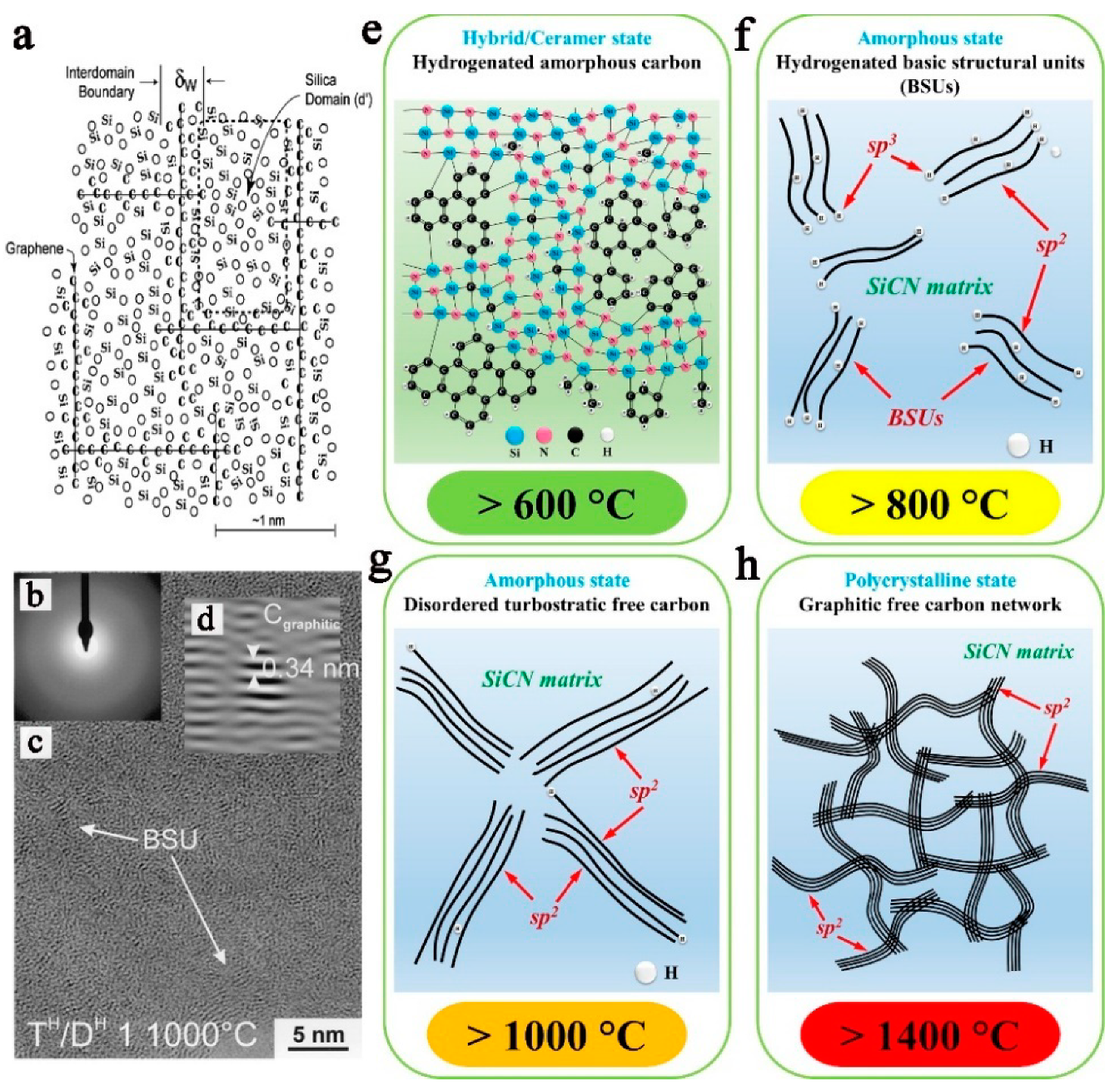
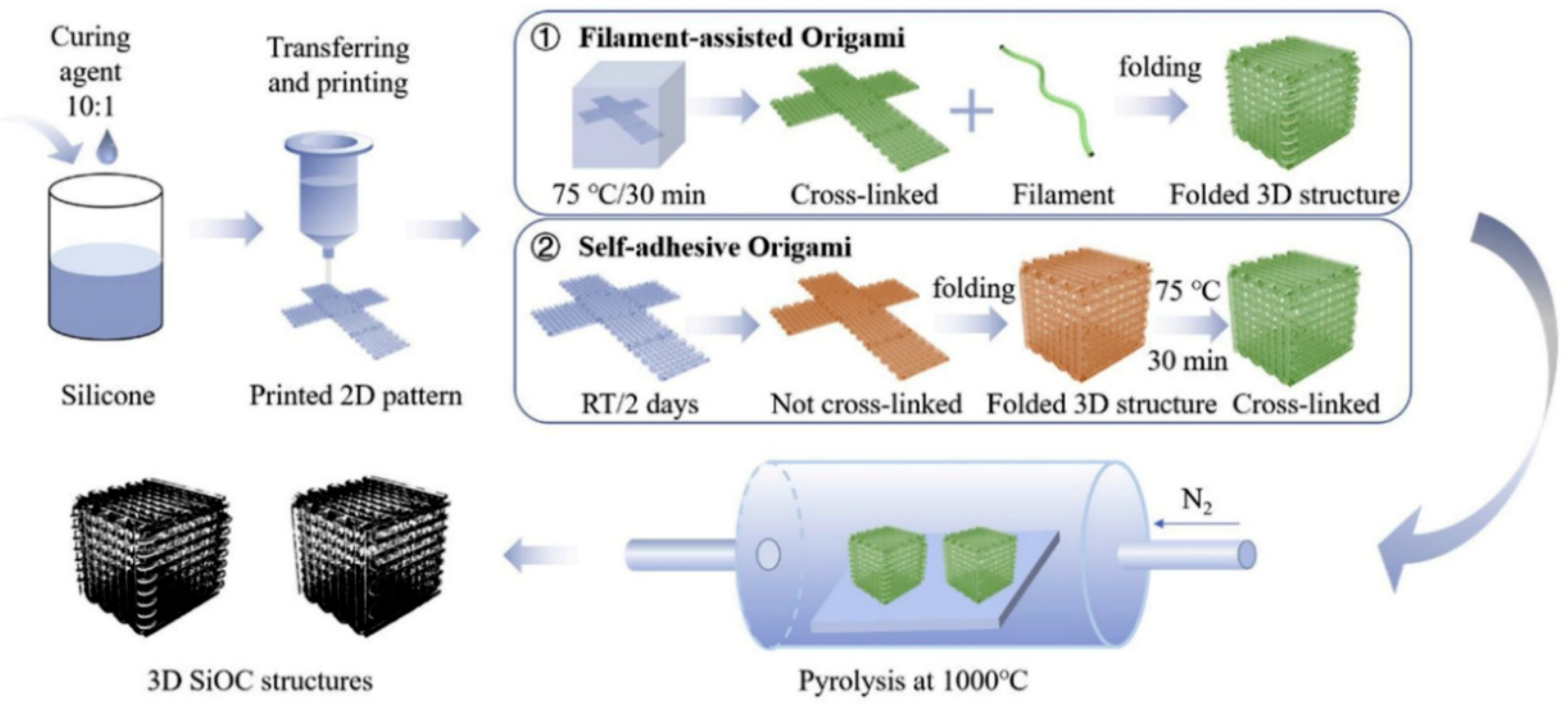
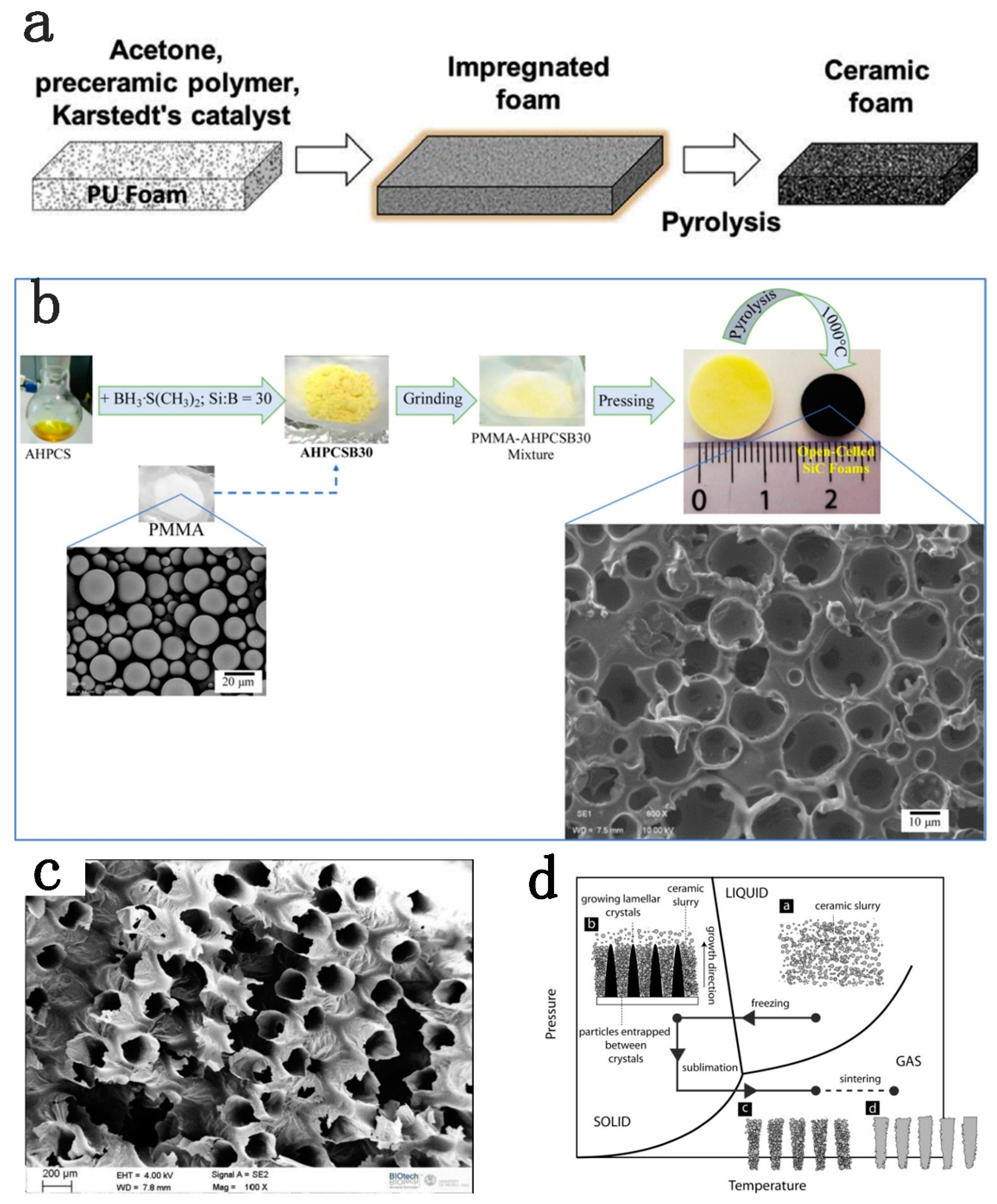
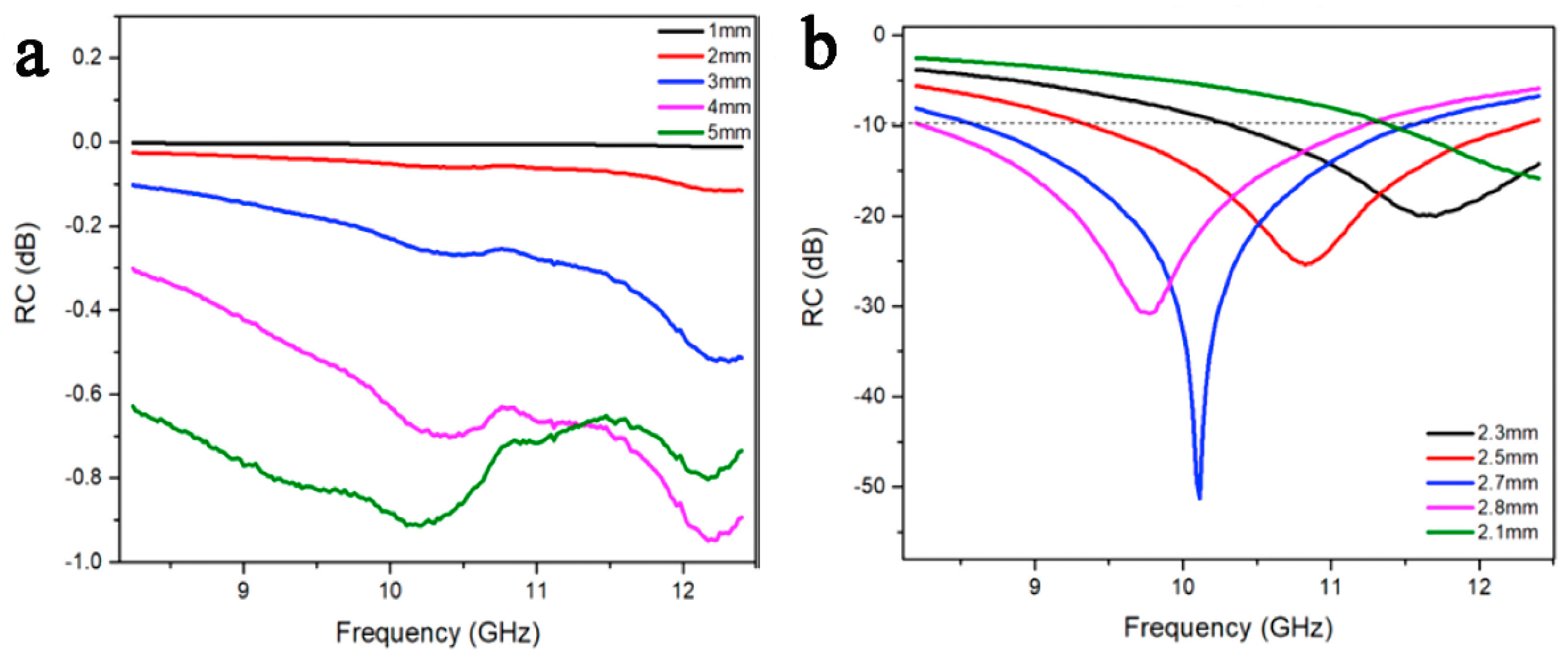
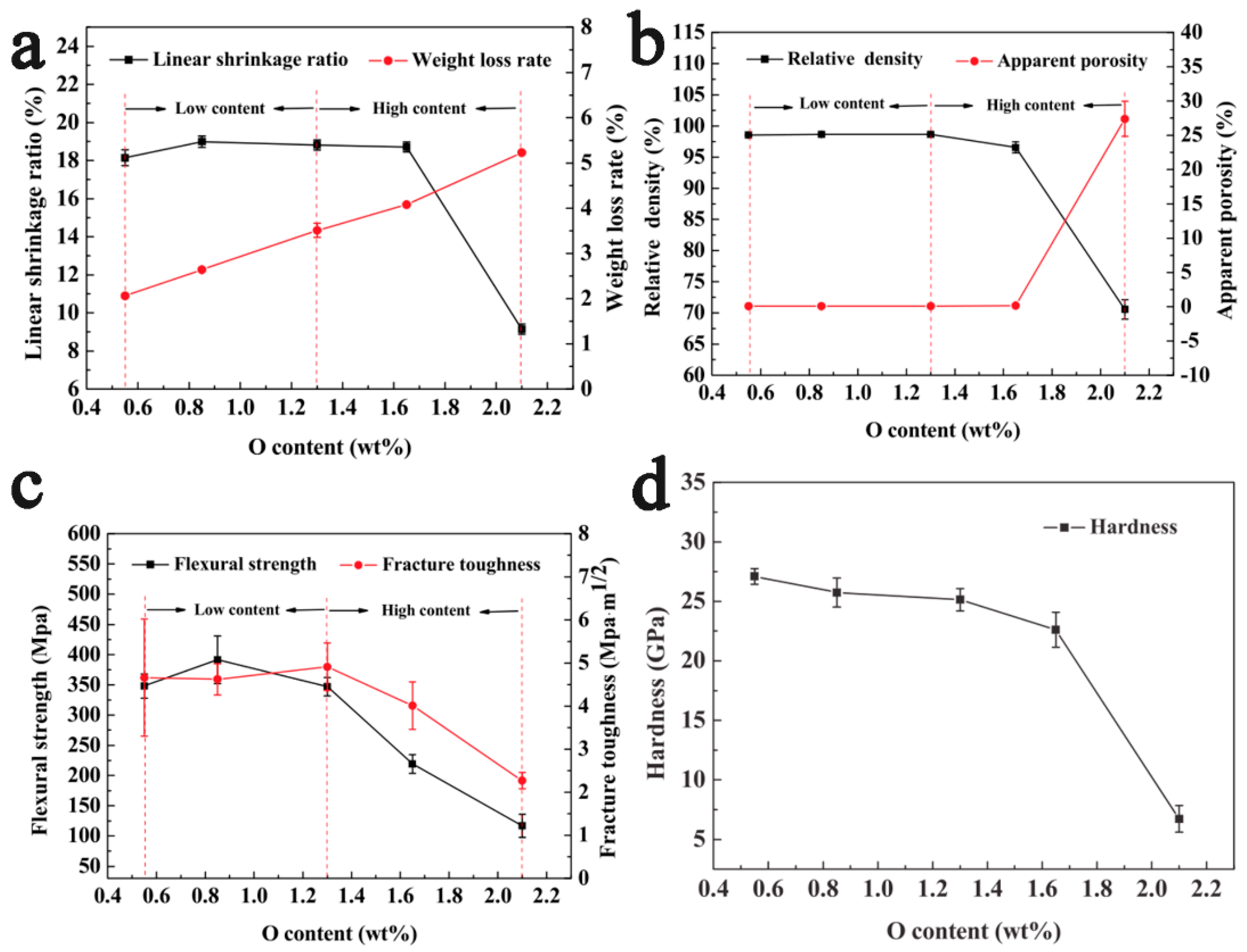
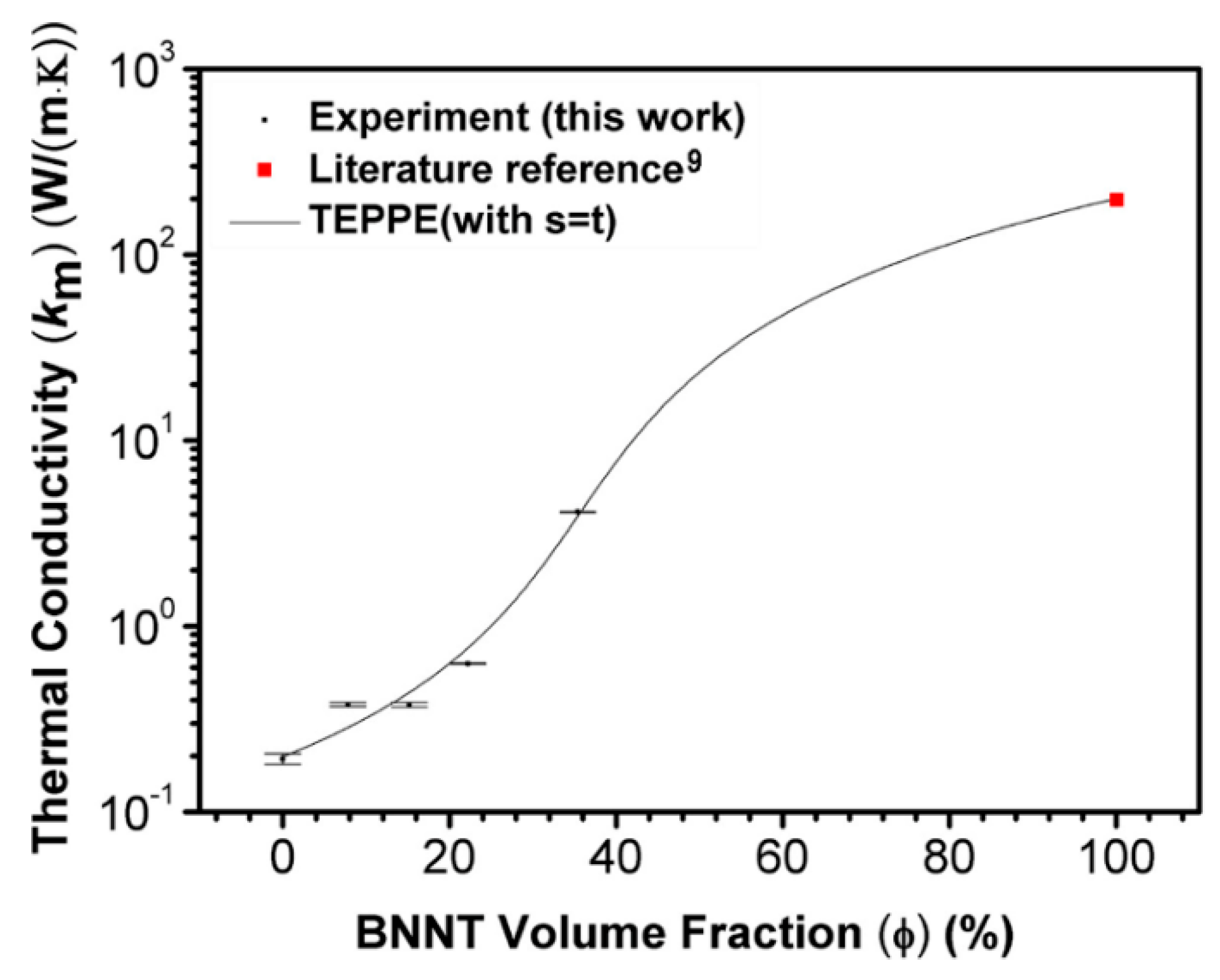

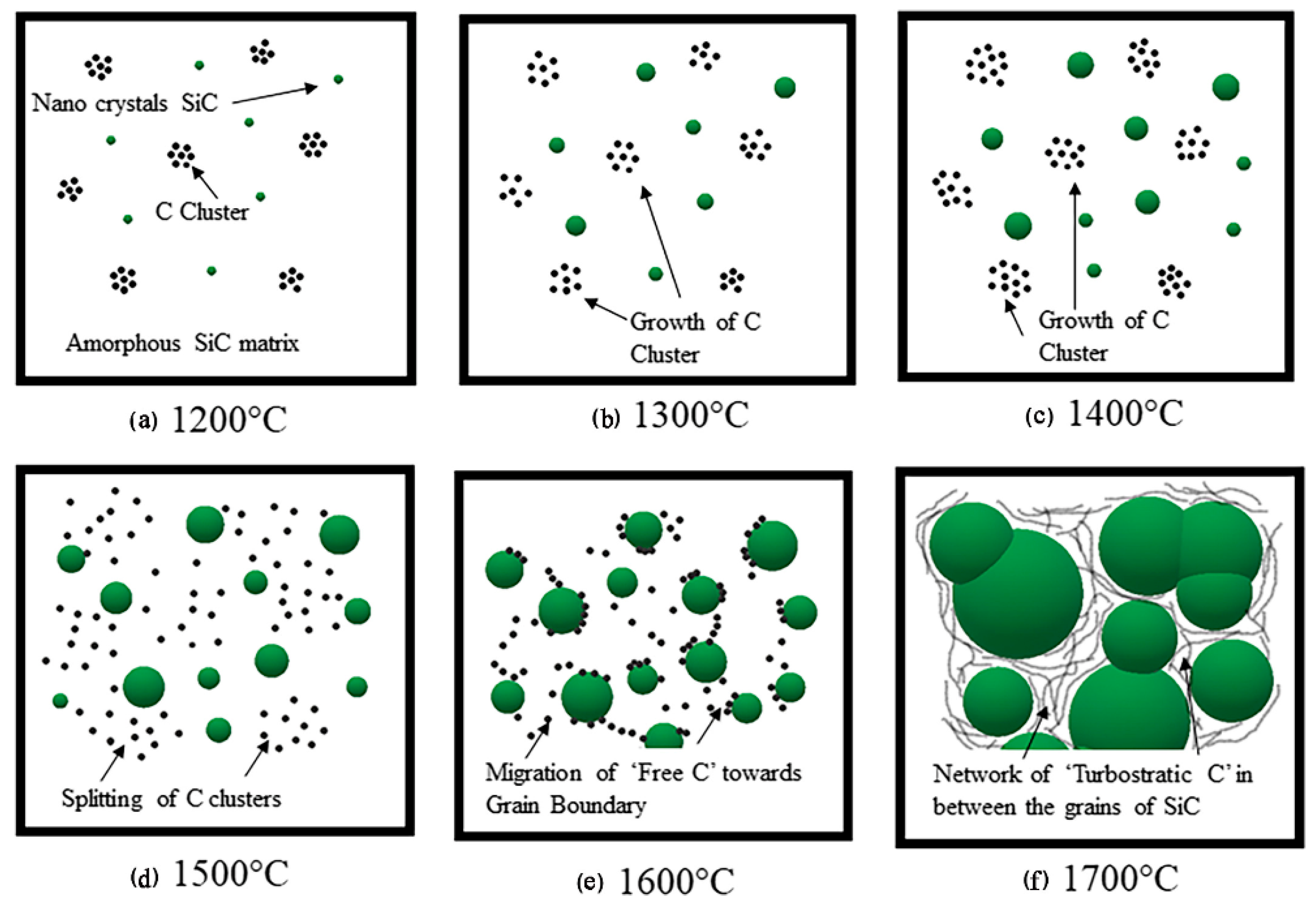
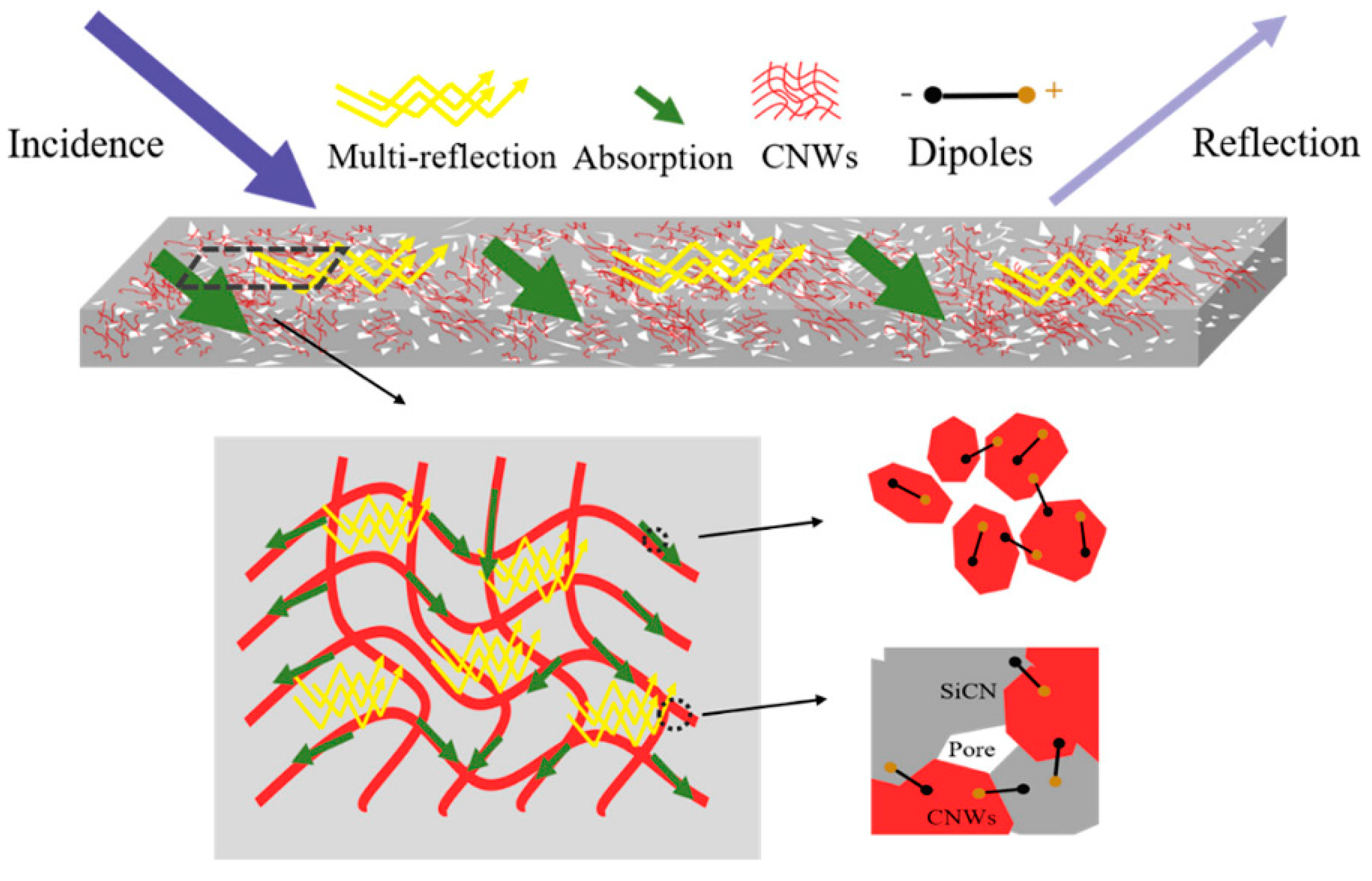
© 2020 by the authors. Licensee MDPI, Basel, Switzerland. This article is an open access article distributed under the terms and conditions of the Creative Commons Attribution (CC BY) license (http://creativecommons.org/licenses/by/4.0/).
Share and Cite
Xia, A.; Yin, J.; Chen, X.; Liu, X.; Huang, Z. Polymer-Derived Si-Based Ceramics: Recent Developments and Perspectives. Crystals 2020, 10, 824. https://doi.org/10.3390/cryst10090824
Xia A, Yin J, Chen X, Liu X, Huang Z. Polymer-Derived Si-Based Ceramics: Recent Developments and Perspectives. Crystals. 2020; 10(9):824. https://doi.org/10.3390/cryst10090824
Chicago/Turabian StyleXia, Aidong, Jie Yin, Xiao Chen, Xuejian Liu, and Zhengren Huang. 2020. "Polymer-Derived Si-Based Ceramics: Recent Developments and Perspectives" Crystals 10, no. 9: 824. https://doi.org/10.3390/cryst10090824
APA StyleXia, A., Yin, J., Chen, X., Liu, X., & Huang, Z. (2020). Polymer-Derived Si-Based Ceramics: Recent Developments and Perspectives. Crystals, 10(9), 824. https://doi.org/10.3390/cryst10090824





